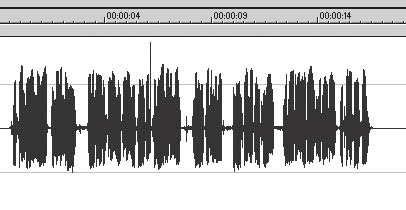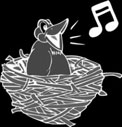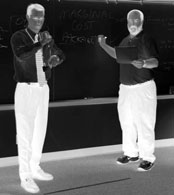Yes, though it may seem impossible, people without both sight and hearing can learn to read, write, and communicate with others. Students may have heard of Helen Keller. Although she could not see or hear, she authored many books and reached a worldwide audience.
Assessment:
She helped others understand that the abilities to communicate and Ask students to com-function in society reside in our brains and are not tied to any one of pare sounds that ani-our five senses.
mals use for
communication with
15. Ask the class to remember the “Birdsong” story. How do animals use their ability to communicate? How is animal communication words spoken by
similar to or different from human communication? Ask students if humans. Do students
they think that studying animals can help us understand human recognize that, similar
communication. Why or why not?
to words, animal
sounds are made up
Animals need to communicate for a variety of reasons, such as to find of a series of repetitive
a mate, warn other members of their group of danger, or find their sounds or a combina-parents. Students should realize that animal communication is similar to human communication in that animals also take in sounds through tion of sounds to con-their ears and process the information using their brains. Some stu-vey meaning? Do they
dents may feel that because no other animals use spoken language, understand that, as in
they are of limited usefulness in exploring human communication.
humans, animals take
You can mention that mammals share many anatomical and physiolog-in sound through their
ical features with humans. Mammals also have similar versions of ears and interpret it in
many human genes. These similarities are being used to investigate the relationship between hearing and communication. The comparison of their brains?
the human and mouse genomes is very helpful in this regard.
59
Student Lesson 1
How Your Brain Understands What Your Ear Hears
Lesson 1 Organizer
Activity 1: What Did You Say?
What the Teacher Does
Procedure Reference
Review with class how they learned language as children.
Page 53
Steps 1–3
Log onto the student Web site and click on “Lesson 1—Get-
Page 54
ting the Message.”
Step 4
Play Tracks 1–3 in sequence, and ask students what infor-
Page 54
mation they can gain from the readings, such as
Step 5
• Is the speaker male or female?
• Does the speaker sound angry, happy, or calm?
• Can they understand any of what is being said?
Play Track 4 (American Sign Language) and ask students
Page 54
if they can tell what is being communicated.
Step 6
Play Tracks 5 and 6 (modern and traditional English) and
Page 54
ask the class if they now can understand what is being said.
Steps 7–9
Examine sound patterns of speech on Master 1.1, The
Page 54
Rhythm of Language.
Step 10
Review the types of information that can be obtained
Page 55
without understanding the language.
Step 11
Discuss the consequences of not hearing language when
Page 55
young.
Step 12
= Involves using the Internet.
= Involves using a transparency.
60
Activity 2: When the Time Is Right
What the Teacher Does
Procedure Reference
Have students read “Birdsong” from Master 1.2, Stories Pages 55–56
of Language Development, and relate it to human
Steps 1–3
development.
Have students read “Wild Child” from Master 1.2, Stories of Pages 56–57
Language Development.
Steps 4 and 5
• Relate it to the concept of a critical period for language development.
• Discuss possible explanations for Victor’s lack of verbal development.
Work with students to construct “The Path to
Pages 57–59
Understanding.”
Steps 6–13
Discuss how a person who has neither sight nor hearing
Page 59
can communicate.
Step 14
Have the class consider how animal communication and
Page 59
human communication are alike and different.
Step 15
61
Student Lesson 1




The Rhythm of Language
Master 1.1


Stories of Language Development
BIRDSONG
A male white-crowned sparrow usually begins singing its full song between 100 and 200 days of age.
Having the proper song is necessary for mating and marking its territory. However, to learn its song, the young bird must be exposed to an adult bird’s song consistently and frequently between one week and two months after hatching. That is its critical period for learning its song. Both before and after this critical period, the male sparrow is unable to use any adult sounds to learn its characteristic song.
WILD CHILD
In 1799 in Aveyron, France, a boy thought to be about 11 or 12 years old was discovered in the woods foraging for food. He became known as the “wild child of Aveyron,” because he behaved like an animal. He happily ate spoiled food, did not distinguish between hot and cold, thought nothing of romp-ing unclothed through the snow, spent much of his time rocking back and forth like a caged animal, showed and accepted no affection, and possessed no verbal language. He was taken into the care of a French scientist, who spent a number of years trying to educate the boy. Victor, as he was named, eventually learned some basic skills and developed some language comprehension. However, he learned to say only two expressions: “milk” and “Oh, God.”
Master 1.2

Lesson 2
Explore/
Explain
Sound Communication
Figure 2.1. Human communication
can involve both sight and sound.
Overview
At a Glance
Students watch and listen to human speech and explore visual and audio cues that aid their understanding. During a short walk, students listen to the sounds around them and classify them as environmental, voiced, or musical.
Major Concepts
The most effective communication is multisensory. Sound is a powerful and important means of communication. There are three categories of sounds: environmental, voiced, and musical.
Objectives
After completing this lesson, students will
• understand that sound is a powerful means of communication;
• appreciate that both audio and visual cues aid their understanding of speech;
• explain why the most effective communication is multisensory;
• realize that there are sounds around them that they take for granted; and
• be able to list the categories of sound (environmental, voiced, and musical).
65
How Your Brain Understands What Your Ear Hears
Teacher Background
Consult the following sections in Information about Hearing, Communication, and Understanding:
3 Major Concepts Related to Hearing and Communication (page 27) 3.1 Communication is multisensory (page 27)
3.2 Language acquisition: imprinting and critical periods (pages 28–29) 3.3 Sound has a physical basis (pages 29–32)
3.4 Perception of sound has a biological basis (pages 32–38) In Advance
Web-Based Activities
Activity
Web Version?
1
No
2
No
Photocopies
Activity 1
no photocopies needed
Activity 2
Master 2.1, Sound Safari Data Sheet (Make 1 copy per student and prepare an overhead transparency.)
Materials
Activity 1
no materials (except photocopies)
Activity 2
no materials (except photocopies)
Preparation
Activity 1
No preparations needed.
Activity 2
Make photocopies and overhead transparency of Master 2.1, Sound Safari Data Sheet.
66
Activity 1: How Do We Understand?
Procedure
Teacher note
The purpose of this activity is twofold. First, it helps students become aware of sounds they experience and normally take for granted. Second, it sets the stage for thinking about sound in terms of its loudness, pitch, and timing. As the module concludes, students will reflect on their own sound exposure and provide recommendations about how they can minimize their risk of noise-induced hearing loss.
PART 1—VISUAL CUES
1. Remind the class that the previous lesson focused on human communication. If you have saved the Path to Understanding diagram from Lesson 1, review it with the class. Explain to students that they will now explore how humans understand what they hear.
2. Illustrate the multisensory nature of communication by silently mouthing a sentence such as, “I wonder if you can read my lips.”
Ask the class if they can repeat the sentence that you mouthed.
Students may be able to pick out some of the words, but the meaning of the sentence will remain obscure. If you have a hearing-impaired student in the class who is adept at reading lips, ask him or her to let the rest of the class respond first.
3. Next, silently mouth a sentence such as, “You’re the best class that I’ve ever had,” while conveying a happy facial expression. As before, the exact meaning of the sentence will be obscure. Ask the class if they think the sentence was conveying a happy, sad, or angry thought. On what did the students base their impression?
You should stress that facial expressions help represent the emotion behind speech.
4. Finally, silently mouth a sentence such as, “I’ve just won $1 million in the lottery.” This time use a facial expression that conveys an angry or sad emotional state and ask the class to identify the emotion behind the sentence. Again, ask students to explain the basis for their answers.
The mixed messages sent by the mouthed words and the facial expression make the meaning of the sentence more difficult to establish.
67
Student Lesson 2


How Your Brain Understands What Your Ear Hears
5. Ask the class to summarize how visual cues influence communication and understanding.
Students should realize that visual cues, such as facial expressions, affect how others interpret what is said.
Figure 2.2. Facial expressions can convey emotion.
PART 2—INTONATION CUES
1. Ask the class whether they can think of any other aspects of speech (aside from the words spoken and visual cues) that help convey meaning.
Answers may vary. Be alert to answers that speak to characteristics about the speaker and not the meaning of what is being spoken (for example, accents and vocabulary).
2. Write the following sentence on the board, “The blue fish is too big for that tank.” Read the sentence aloud to the class, stressing the word “blue” as depicted in example a below, and have students discuss the meaning. Repeat the sentence stressing different words and discuss how the meaning of the sentence changes. Does this sentence always convey the same meaning?
For example:
a. The blue fish is too big for that tank. (Meaning: The blue fish is too big, but fish of other colors are the appropriate size.) b. The blue fish is too big for that tank. (Meaning: The blue fish is too big, but other blue creatures are the appropriate size.) c. The blue fish is too big for that tank. (Meaning: The blue fish is too big for that tank but may be the appropriate size for some other tank.)
68

3. Ask students to suggest another sentence that can take on different meanings depending on how it is said. Write the sentence on the board, and ask the class to see how many ways it can be read to give different meanings.
Another sentence that can take on different meanings depending on which words are stressed is, “We are going to the mall tomorrow.”
4. Ask the class to summarize how the manner in which words are spoken can affect our understanding.
Review the idea of how word stress changes the meaning of a sentence. Relate to students that actors often practice saying a line in different ways that change the meaning of the words being spoken.
Figure 2.3. The
meaning of spoken
words can change
depending on how the
words are spoken.
PART 3—EMOTIONAL CUES
1. Ask the class, Can you detect the emotional state of the person speaking by his or her tone alone, or do you need to understand the words being spoken?
Answers will vary, though many students will believe that they can identify the speaker’s emotional state just by hearing the tone and not the words.
2. Test this idea by speaking a random string of numbers to the class, such as 7, 52, 12, 39, 75. Use a voice that suggests a specific emotion, such as anger, and ask the students to identify the emotion.
To avoid giving the class any visual cues from your facial expression, you might face away from the class while speaking.
3. Ask for a volunteer to repeat the test by speaking a different string of numbers and using a different emotion. See if the class can identify the emotion. Repeat the test using different students, numbers, and emotions.
69
Student Lesson 2

How Your Brain Understands What Your Ear Hears
Again, have the speaker face away from the class to eliminate cues from facial expressions.
4. To reinforce the importance of multisensory communication, ask Content Standard C:
the class what other factors, besides hearing, help us communicate with others.
Behavior is one kind of
response an organism
Answers should include the idea that visual cues, such as facial can make to an inter-expressions and body language, help our brain interpret the speech nal or environmental
that we hear.
stimulus
5. Wrap up the activity by asking students to list ways, other than speech, in which we can communicate.
Answers will vary but may include
reading and writing
body language
sign language
gestures
facial expressions
whistling
Activity 2: Sound Safari
Teacher note
The sound safari consists of a simple, five-minute walk down the school hallway. Decide ahead of time where the class will walk. Ideally, students will walk by areas that have a wide variety of sounds, such as the cafeteria, music class, and shop class. If weather permits, you might consider taking part of the walk outdoors.
1. Remind the class that we categorize sounds as voiced, musical, or environmental. Ask students to give some examples of each category.
2. Explain to the class that they will take a short walk. Instruct students not to talk to each other during the walk and to keep noise to a minimum.
The goal is to concentrate on the number and types of sounds around them and list as many of them as possible. For the purposes of this activity, students should ignore any sounds made by students in the class (such as talking, coughing, feet shuffling, and writing) and only pay attention to those sounds that aren’t produced by the class.
70




3. Give each student a copy of Master 2.1, Sound Safari Data Sheet.
Explain that each of the sounds they list can be classified as voiced, musical, or environmental. Instruct students to list each of their sounds in the appropriate column on their data sheet.
Content Standard A:
Environmental sounds are simply those that are not voiced or musical.
Different kinds of
questions suggest dif-
4. After returning to the classroom, place an overhead transparency ferent kinds of scien-of Master 2.1, Sound Safari Data Sheet, on the overhead projector.
tific investigations.
Ask students to call out the voiced sounds from their data sheets and write them down on the transparency. Repeat this process for Some investigations
the musical and environmental sounds.
involve observing and
describing objects,
5. Ask students whether their list of sounds was the same as organisms, or events;
that written on the transparency. Ask the class to account for some involve collect-differences.
ing specimens; some
Students will have many of the same sounds on their lists. Differ-involve experiments;
ences arise when sounds are hard to hear or are ever present and some involve seeking
therefore difficult to notice.
more information;
some involve discovery
6. To conclude this activity, remind the class that visual and audio of new objects and
cues help us better understand speech. Ask the class if they can phenomena; and
think of similar cues that help us understand musical and environ-some involve making
mental sounds.
models.
Context is important. A piece of music played during a parade may convey a different emotion from the same music played at a funeral.
A whistle blown by a policeman directing traffic has a different meaning from a whistle blown by an official at a sporting event.
Assessment:
Ask students to sum-
marize, in writing, their
thoughts about how
audio and visual cues
influence our ability to
gain meaning from
sound. Ask them to
provide specific exam-
ples of sounds that
Figure 2.4. The same sound can have different meanings that depend on can have different
context.
meanings depending
upon their context. Ask
students to share their
ideas with the class.
71
Student Lesson 2
How Your Brain Understands What Your Ear Hears
Lesson 2 Organizer
Activity 1: How Do We Understand?
What the Teacher Does
Procedure Reference
Review the Path to Understanding diagram from Lesson 1.
Page 67
Part 1, Step 1
Silently mouth the sentence, “I wonder if you can read my Page 67
lips,” to the class.
Part 1, Step 2
• Ask students if they can repeat the sentence.
Use a happy expression to mouth the sentence, “You’re the Page 67
best class that I’ve ever had.”
Part 1, Step 3
• Ask students to identify the emotion.
Use an angry or sad expression to mouth the sentence, “I’ve Page 67
just won $1 million in the lottery.”
Part 1, Step 4
• Ask students to identify the emotion.
Ask the class to summarize the roles of visual cues in
Page 68
human communication.
Part 1, Step 5
Ask the students whether other aspects of speech convey
Page 68
meaning.
Part 2, Step 1
Write the sentence, “The blue fish is too big for that tank,”
Page 68
on the board.
Part 2, Step 2
• Discuss how emphasizing different words can affect
meaning.
Have students suggest another sentence that can convey
Page 69
different meanings depending on how it is said.
Part 2, Step 3
= Involves copying a master.
= Involves using a transparency.
72
Summarize how word stress and intonation can affect
Page 69
meaning.
Part 2, Step 4
Ask if a speaker’s emotion affects understanding.
Page 69
Part 3, Step 1
Recite a random series of numbers using a voice that
Pages 69–70
conveys a specific emotion.
Part 3, Steps 2 and 3
• Ask students to identify the emotion.
• Repeat the activity having a student recite numbers
using a different emotion.
Reinforce the importance of multisensory communication.
Page 70
• What factors, besides hearing, help us communicate?
Part 3, Steps 4 and 5
• How can we communicate without using speech?
Activity 2: Sound Safari
What the Teacher Does
Procedure Reference
Have students give examples of voiced, musical, and environ-Pages 70–71
mental sounds.
Steps 1–3
Take class on a short walk through the school.
Pages 70–71
• Have students record the sounds the


















